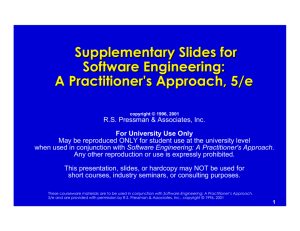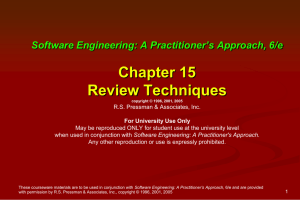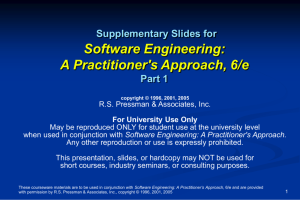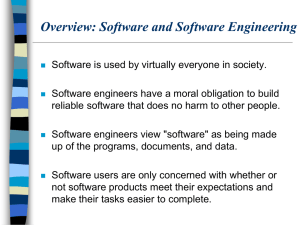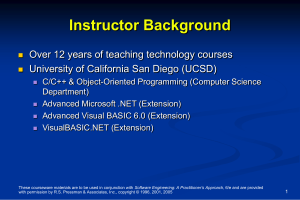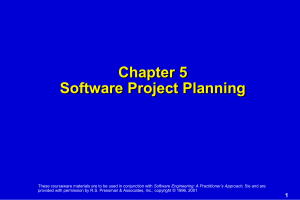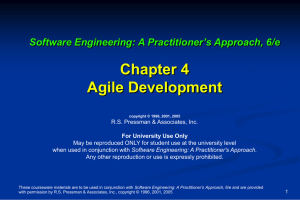Chapter 12 User Interface Design Software Engineering: A Practitioner’s Approach, 6/e
advertisement
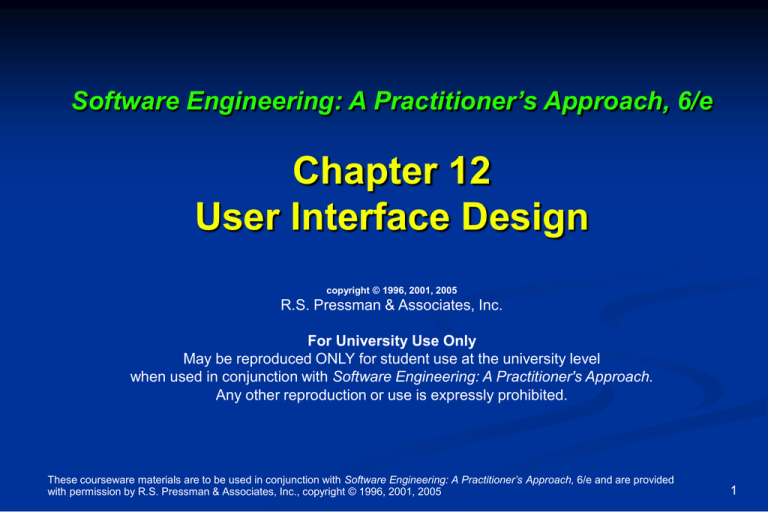
Software Engineering: A Practitioner’s Approach, 6/e Chapter 12 User Interface Design copyright © 1996, 2001, 2005 R.S. Pressman & Associates, Inc. For University Use Only May be reproduced ONLY for student use at the university level when used in conjunction with Software Engineering: A Practitioner's Approach. Any other reproduction or use is expressly prohibited. These courseware materials are to be used in conjunction with Software Engineering: A Practitioner’s Approach, 6/e and are provided with permission by R.S. Pressman & Associates, Inc., copyright © 1996, 2001, 2005 1 Interface Design Easy to learn? Easy to use? Easy to understand? These courseware materials are to be used in conjunction with Software Engineering: A Practitioner’s Approach, 6/e and are provided with permission by R.S. Pressman & Associates, Inc., copyright © 1996, 2001, 2005 2 Interface Design Typical Design Errors lack of consistency too much memorization no guidance / help no context sensitivity poor response Arcane/unfriendly These courseware materials are to be used in conjunction with Software Engineering: A Practitioner’s Approach, 6/e and are provided with permission by R.S. Pressman & Associates, Inc., copyright © 1996, 2001, 2005 3 Golden Rules Place the user in control Reduce the user’s memory load Make the interface consistent These courseware materials are to be used in conjunction with Software Engineering: A Practitioner’s Approach, 6/e and are provided with permission by R.S. Pressman & Associates, Inc., copyright © 1996, 2001, 2005 4 Place the User in Control Define interaction modes in a way that does not force a user into unnecessary or undesired actions. Provide for flexible interaction. Allow user interaction to be interruptible and undoable. Streamline interaction as skill levels advance and allow the interaction to be customized. Hide technical internals from the casual user. Design for direct interaction with objects that appear on the screen. These courseware materials are to be used in conjunction with Software Engineering: A Practitioner’s Approach, 6/e and are provided with permission by R.S. Pressman & Associates, Inc., copyright © 1996, 2001, 2005 5 Reduce the User’s Memory Load Reduce demand on short-term memory. Establish meaningful defaults. Define shortcuts that are intuitive. The visual layout of the interface should be based on a real world metaphor. Disclose information in a progressive fashion. These courseware materials are to be used in conjunction with Software Engineering: A Practitioner’s Approach, 6/e and are provided with permission by R.S. Pressman & Associates, Inc., copyright © 1996, 2001, 2005 6 Make the Interface Consistent Allow the user to put the current task into a meaningful context. Maintain consistency across a family of applications. If past interactive models have created user expectations, do not make changes unless there is a compelling reason to do so. These courseware materials are to be used in conjunction with Software Engineering: A Practitioner’s Approach, 6/e and are provided with permission by R.S. Pressman & Associates, Inc., copyright © 1996, 2001, 2005 7 User Interface Design Models User model — a profile of all end users of the system Design model — a design realization of the user model Mental model (system perception) — the user’s mental image of what the interface is Implementation model — the interface “look and feel” coupled with supporting information that describe interface syntax and semantics These courseware materials are to be used in conjunction with Software Engineering: A Practitioner’s Approach, 6/e and are provided with permission by R.S. Pressman & Associates, Inc., copyright © 1996, 2001, 2005 8 User Interface Design Process These courseware materials are to be used in conjunction with Software Engineering: A Practitioner’s Approach, 6/e and are provided with permission by R.S. Pressman & Associates, Inc., copyright © 1996, 2001, 2005 9 Interface Analysis Interface analysis means understanding (1) the people (end-users) who will interact with the system through the interface; (2) the tasks that end-users must perform to do their work, (3) the content that is presented as part of the interface (4) the environment in which these tasks will be conducted. These courseware materials are to be used in conjunction with Software Engineering: A Practitioner’s Approach, 6/e and are provided with permission by R.S. Pressman & Associates, Inc., copyright © 1996, 2001, 2005 10 User Analysis Are users trained professionals, technician, clerical, or manufacturing workers? What level of formal education does the average user have? Are the users capable of learning from written materials or have they expressed a desire for classroom training? Are users expert typists or keyboard phobic? What is the age range of the user community? Will the users be represented predominately by one gender? How are users compensated for the work they perform? Do users work normal office hours or do they work until the job is done? Is the software to be an integral part of the work users do or will it be used only occasionally? What is the primary spoken language among users? What are the consequences if a user makes a mistake using the system? Are users experts in the subject matter that is addressed by the system? Do users want to know about the technology the sits behind the interface? These courseware materials are to be used in conjunction with Software Engineering: A Practitioner’s Approach, 6/e and are provided with permission by R.S. Pressman & Associates, Inc., copyright © 1996, 2001, 2005 11 Task Analysis and Modeling Answers the following questions … What work will the user perform in specific circumstances? What tasks and subtasks will be performed as the user does the work? What specific problem domain objects will the user manipulate as work is performed? What is the sequence of work tasks—the workflow? What is the hierarchy of tasks? Use-cases define basic interaction Task elaboration refines interactive tasks Object elaboration identifies interface objects (classes) Workflow analysis defines how a work process is completed when several people (and roles) are involved These courseware materials are to be used in conjunction with Software Engineering: A Practitioner’s Approach, 6/e and are provided with permission by R.S. Pressman & Associates, Inc., copyright © 1996, 2001, 2005 12 Swimlane Diagram These courseware materials are to be used in conjunction with Software Engineering: A Practitioner’s Approach, 6/e and are provided with permission by R.S. Pressman & Associates, Inc., copyright © 1996, 2001, 2005 13 Analysis of Display Content Are different types of data assigned to consistent geographic locations on the screen (e.g., photos always appear in the upper right hand corner)? Can the user customize the screen location for content? Is proper on-screen identification assigned to all content? If a large report is to be presented, how should it be partitioned for ease of understanding? Will mechanisms be available for moving directly to summary information for large collections of data. Will graphical output be scaled to fit within the bounds of the display device that is used? How will color to be used to enhance understanding? How will error messages and warning be presented to the user? These courseware materials are to be used in conjunction with Software Engineering: A Practitioner’s Approach, 6/e and are provided with permission by R.S. Pressman & Associates, Inc., copyright © 1996, 2001, 2005 14 Interface Design Steps Using information developed during interface analysis (SEPA, Section 12.3), define interface objects and actions (operations). Define events (user actions) that will cause the state of the user interface to change. Model this behavior. Depict each interface state as it will actually look to the end-user. Indicate how the user interprets the state of the system from information provided through the interface. These courseware materials are to be used in conjunction with Software Engineering: A Practitioner’s Approach, 6/e and are provided with permission by R.S. Pressman & Associates, Inc., copyright © 1996, 2001, 2005 15 Interface Design Patterns Patterns are available for The complete UI Page layout Forms and input Tables Direct data manipulation Navigation Searching Page elements e-Commerce These courseware materials are to be used in conjunction with Software Engineering: A Practitioner’s Approach, 6/e and are provided with permission by R.S. Pressman & Associates, Inc., copyright © 1996, 2001, 2005 16 Design Issues Response time Help facilities Error handling Menu and command labeling Application accessibility Internationalization These courseware materials are to be used in conjunction with Software Engineering: A Practitioner’s Approach, 6/e and are provided with permission by R.S. Pressman & Associates, Inc., copyright © 1996, 2001, 2005 17 Design Evaluation Cycle These courseware materials are to be used in conjunction with Software Engineering: A Practitioner’s Approach, 6/e and are provided with permission by R.S. Pressman & Associates, Inc., copyright © 1996, 2001, 2005 18
